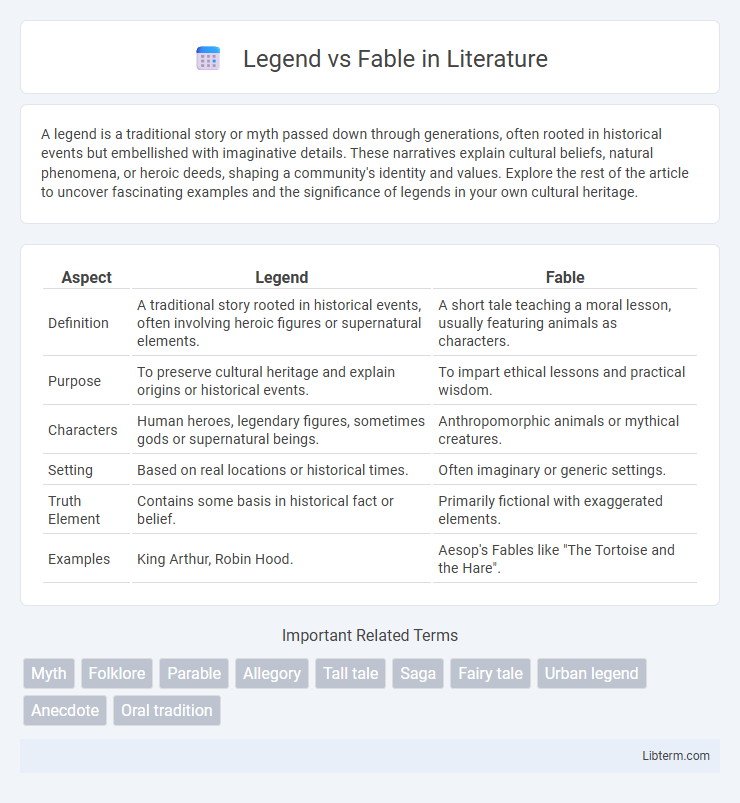A legend is a traditional story or myth passed down through generations, often rooted in historical events but embellished with imaginative details. These narratives explain cultural beliefs, natural phenomena, or heroic deeds, shaping a community's identity and values. Explore the rest of the article to uncover fascinating examples and the significance of legends in your own cultural heritage.
Table of Comparison
| Aspect | Legend | Fable |
|---|---|---|
| Definition | A traditional story rooted in historical events, often involving heroic figures or supernatural elements. | A short tale teaching a moral lesson, usually featuring animals as characters. |
| Purpose | To preserve cultural heritage and explain origins or historical events. | To impart ethical lessons and practical wisdom. |
| Characters | Human heroes, legendary figures, sometimes gods or supernatural beings. | Anthropomorphic animals or mythical creatures. |
| Setting | Based on real locations or historical times. | Often imaginary or generic settings. |
| Truth Element | Contains some basis in historical fact or belief. | Primarily fictional with exaggerated elements. |
| Examples | King Arthur, Robin Hood. | Aesop's Fables like "The Tortoise and the Hare". |
Understanding Legends: Definition and Characteristics
Legends are traditional narratives rooted in historical events or figures, often blending fact with myth to explain cultural beliefs and values. They typically feature heroic characters, supernatural elements, and moral lessons, serving as a bridge between history and folklore. Understanding legends involves recognizing their role in preserving collective memory and shaping community identity through storytelling.
What Defines a Fable? Core Elements Explained
A fable is defined by its use of anthropomorphic animals or inanimate objects as characters that convey moral lessons through concise, straightforward narratives. Core elements include a clear moral or ethical message, simple plotlines designed to teach values, and universal themes that transcend cultures and time. These stories serve as educational tools, often culminating in a direct statement of the moral for clarity and impact.
Origins: Tracing the Roots of Legends and Fables
Legends trace their origins to historical events or figures embellished over time to convey cultural values and moral lessons, often rooted in specific places or communities. Fables originate from ancient oral traditions, featuring anthropomorphic animals or objects to illustrate ethical principles in a simple, memorable format. Both genres serve as foundational storytelling methods, evolving to reflect societal beliefs and educational purposes across civilizations.
Key Differences Between Legends and Fables
Legends are narrative stories rooted in historical events or figures, often blending fact with folklore to highlight cultural values and heroic exploits. Fables are brief, fictional tales that feature anthropomorphic animals or objects and conclude with a moral lesson intended for educational purposes. The key difference lies in legends' emphasis on cultural identity and historical context, whereas fables prioritize teaching ethical principles through simple, illustrative storytelling.
Common Themes in Legends vs Fables
Legends and fables both center around moral lessons but differ in their storytelling approach; legends often highlight heroic deeds and historical events rooted in cultural identity, while fables use anthropomorphic animals to impart ethical teachings through simple narratives. Common themes in legends include bravery, honor, and the supernatural, reflecting societal values and historical context, whereas fables emphasize wisdom, justice, and practical life lessons aimed at guiding behavior. Both genres underscore human virtues and flaws, serving as educational tools that preserve cultural heritage and social norms.
Purpose and Function in Society
Legends serve to preserve cultural heritage and historical events by blending factual elements with imaginative details, often inspiring communal identity and moral lessons. Fables primarily function as instructional tales, using animals or mythical creatures to embody human traits and convey ethical guidelines or social norms. Both genres reinforce societal values, but legends emphasize collective memory while fables prioritize moral education.
Notable Examples of Famous Legends
King Arthur's legend, renowned for its tales of the Round Table and Excalibur, exemplifies the enduring power of legendary narratives rooted in British folklore. Robin Hood, a legendary English outlaw celebrated for his acts of stealing from the rich to give to the poor, highlights themes of justice and heroism. The legend of Joan of Arc, a French heroine who led troops during the Hundred Years' War, blends historical facts with myth, illustrating the deep cultural impact of legendary figures on national identity.
Popular Fables and Their Moral Lessons
Popular fables such as Aesop's "The Tortoise and the Hare" and "The Boy Who Cried Wolf" convey timeless moral lessons emphasizing virtues like patience, honesty, and humility. These short, allegorical tales use anthropomorphic animals to illustrate ethical principles, making them accessible and memorable for audiences of all ages. Unlike legends, which often focus on historical or heroic figures, fables prioritize moral instruction through symbolic storytelling.
Influence on Modern Culture and Literature
Legends heavily influence modern culture and literature by preserving historical events and heroic figures, often inspiring movies, novels, and folklore adaptations that shape national identities and collective memory. Fables impact contemporary storytelling through their moral lessons and anthropomorphic characters, frequently serving as foundational texts in children's literature and ethical education. Both genres contribute to cultural continuity and creativity by embedding timeless themes and values into popular narratives.
Legends and Fables: Why Distinguishing Them Matters
Legends are traditional stories rooted in historical events or figures, often embellished but grounded in cultural truth, while fables are moral tales typically featuring animals as characters to teach ethical lessons. Distinguishing legends from fables matters because legends preserve cultural heritage and collective memory, whereas fables serve educational purposes through clear moral messages. Understanding this difference enhances the appreciation of narrative forms and their roles in shaping societal values and history.
Legend Infographic

 libterm.com
libterm.com